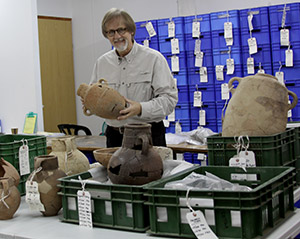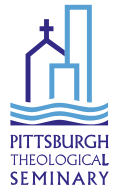 After 10 “seasons in the field,” director of The Zeitah Excavations Dr. Ron Tappy—G. Albert Shoemaker Professor of Bible and Archaeology and Director of the Kelso Museum of Near Eastern Archaeology at PTS—has at least 315,000 potsherds to analyze, catalog, register, draw, record in a database, and/or “type.” All these steps lay the principle basis for dating the other finds from Tel Zayit: layers of debris, architectural features, inscriptions, and “small finds” such as jewelry and glass objects, and stone and metal tools, for example. And the total picture gained from such detailed analysis will appear in a final excavation report to tell the history of the site—and elucidate our understanding of the world in which the events of the Bible took place.
After 10 “seasons in the field,” director of The Zeitah Excavations Dr. Ron Tappy—G. Albert Shoemaker Professor of Bible and Archaeology and Director of the Kelso Museum of Near Eastern Archaeology at PTS—has at least 315,000 potsherds to analyze, catalog, register, draw, record in a database, and/or “type.” All these steps lay the principle basis for dating the other finds from Tel Zayit: layers of debris, architectural features, inscriptions, and “small finds” such as jewelry and glass objects, and stone and metal tools, for example. And the total picture gained from such detailed analysis will appear in a final excavation report to tell the history of the site—and elucidate our understanding of the world in which the events of the Bible took place.
That final, published report is what Ron has been working toward this summer, as well as during nine previous “study seasons” in Israel conducted just down the road from Tel Zayit (Zeitah), where he stores the unearthed finds. “Each potsherd must be analyzed by hand to determine its usefulness for providing historical-chronological information,” Ron notes. “Dealing with the pottery is a daunting task, but it’s an absolutely necessary one.”
Many types of sherds are found in an excavation season. Initially after being unearthed, the sherds are washed, dried in the sun, sorted, many of them “marked” with their “findspot,” bagged and tagged, and stored for further study. “Useful, what we call ‘diagnostic’ sherds get special treatment. They are individually described on a five-page form and often hand-drawn before their attributes are entered into a master computer database.”
“In the last stage, I work with members of my professional team to form a typology, a chart with groups of similar sherds, which can be compared to the typologies of other sites. That comparison helps determine the historical periods of the occupational layers from which the sherds came, and it can also give us a picture of the political relationships, socio-economic ties, and religious affiliations of the people who occupied the site in a given historical period—the history of the site. All from broken pieces of pottery carefully and properly analyzed.” This summer, Ron is continuing his work on the all-important typology.
By the end of the summer, Ron will have “typed” nearly 6,000 of those registered potsherds. “Only 39,000 to go!” he says. Clearly, his task is immense.
“To be a field archaeologist, you have to be not only methodical and observant, but also very patient and persistent,” says Ron. “Publishing a detailed, reliable final report from our excavations at Tel Zayit,” where Ron’s team discovered the oldest known Hebrew alphabet, “will make a lasting contribution to the often-contested picture of biblical Judah during the time of Solomon.” And it will further Pittsburgh Seminary’s distinguished, century-long leadership in the field of biblical and Near Eastern archaeology.
Located in the Lowlands of Israel, Tel Zayit lies at the crossroads of major ancient roadways that facilitated international travel and trade between Egypt and Mesopotamia via Canaan, and that connected Jerusalem with Philistia and the coast. The Zeitah Excavations project rose to global prominence in 2005 after the discovery of a rare, 10th-century BCE Hebrew alphabetic inscription—the Tel Zayit Abecedary.
